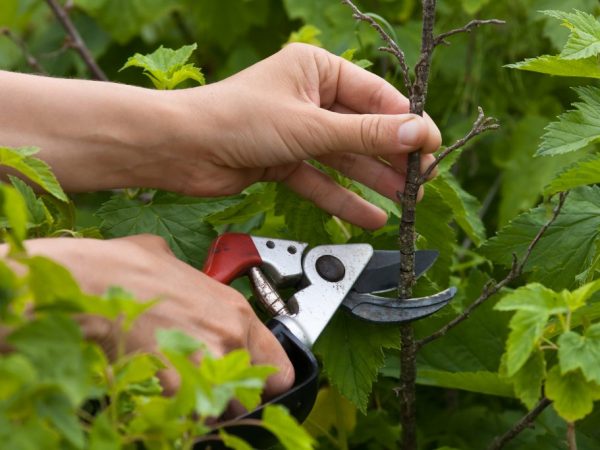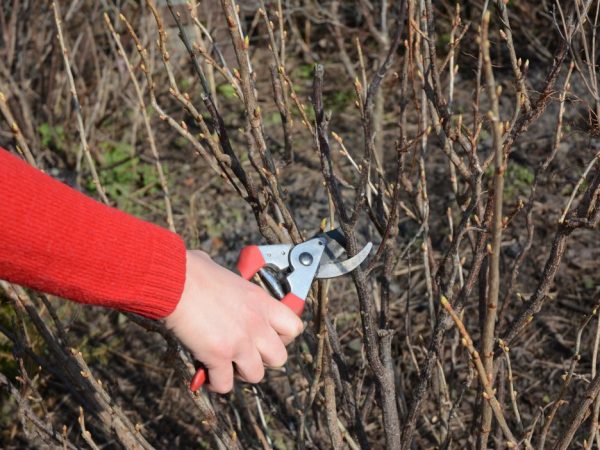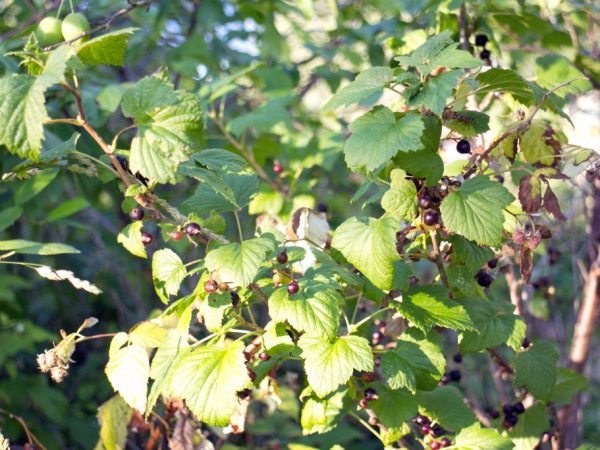Rejuvenation of currants in the fall is the key to a successful harvest for the next year
Every horticultural crop requires a responsibility to care. If you rejuvenate the currants in autumn in time, the next year the shrub will delight you not only with high decorative qualities, but also with a bountiful harvest.

Rejuvenation of currants in the fall is the key to a successful harvest for the next year
The goal of rejuvenation
Any gardener who has currants on his garden plot sooner or later faces the need to rejuvenate old bushes. The obligation of the event is due to the properties of the shrub to give fewer berries with age, the quality of which also decreases.
Such work is required to be carried out not only for aged specimens, but also noticeably affected by the vital activity of harmful insects and diseases. It will not be superfluous to correct currants with a strongly thickened crown or injured root system. The problem in this case is the excessive number of shoots preventing light from entering the green mass. As a result, some of the fruits are small in size and do not have time to ripen in time.
Timely pruning allows you to return the productivity of the shrub to its previous level and increase its immunity to various ailments.
Suitable dates
Opinions differ among gardeners about when it is preferable to prune a plant. However, there is no special criterion regarding this aspect. In favor of the autumn procedure, they attribute the opportunity to contemplate the fruits of their labors as early as the next season.
Activities should be carried out only when the juice ceases to circulate along the branches, which indicates its unpreparedness for the upcoming work. Otherwise, the currants will not have time to prepare for the onset of cold weather and, as a probability, will die.
Shrubs are cut when they reach the age of 5. Rejuvenation of an older one can take several seasons.
The benefits of pruning in the fall include:
- the duration of the time interval that is permissible for the procedure exceeding in comparison with the spring;
- the ability to well prepare the culture for the upcoming frost;
- activation of the growth of new shoots;
- stimulation of fruiting in the next season.
In favor of the spring haircut, it can be attributed to its combination with sanitary correction and the fact that during this period the risk of contracting diseases is much less. Among the minuses, the appearance of berries is distinguished only after a year.
Work should be carried out exclusively in dry weather in order to protect the plant from pathogenic spores spreading in the precipitation.
Instrument preparation
You will need garden saws, preferably fine-toothed saws, scissors and pruning shears. It is important that the entire tool is well sharpened and does not leave “burrs” that additionally injure the plant, which is already under stress.
Devices before pruning are disinfected with potassium permanganate or medical alcohol.The cut branches are subsequently burned in order to prevent the spread of possible diseases.
Features of the procedure
One of the goals of pruning in the fall is the appearance of new shoots that protrude from the ground and are called zero.
To achieve the result, several aged but viable branches are cut out and systematically removed into skeletal thin vertical segments. For maximum and uniform fruiting, it is required to leave 3 zero shoots.
Pruning rules

All slices need to be processed
- A shoot on which a weak growth is observed is shortened so that no more than 5 buds remain on it.
- When determining the cut, preference is given to a place located several centimeters above the kidney.
- It is not recommended to leave large-sized hemp due to the fact that pests can hide in them in the future.
- For uniformity of the crop, branches of different age categories are kept on the plant.
- They regulate the growth of new shoots - almost the same number should appear every year.
- Cut strictly at an angle of 45-50 degrees.
- The number of segments left depends on the development of the culture. On powerful ones, it is allowed to save up to 10-14, on weaker ones - about 5.
- The cut must be disinfected. For this, special purchased preparations, garden pitch or ash can be used.
During the correction, remove:
- damaged and weakened shoots;
- branches directed deep into the crown, as well as creeping along the surface of the soil;
- non-yielding segments.
Recommendations
If it is not possible to determine the age of the processes, it is allowed to carry out a haircut according to a simplified scheme. For this, the bush is annually shortened by ¼ of the total volume of the aboveground part. This approach greatly simplifies agrotechnical work for novice gardeners.
To rejuvenate old specimens, you cannot do without radical pruning, which consists in cutting off all branches at the root. When carrying out the procedure in the fall, the soil surface is mulched with dry straw or wood chips.
As a result, the growth of young shoots from root buds is activated.
If the goal has not been achieved, you should not repeat the procedure. This is due to an imbalance between the crown and the root system.
To preserve the culture, it is allowed to resort to vegetative propagation.
- In May / April, in the lower part of the mother bush, one-year-old shoots are chosen, which they bend down and drop in with earth, not forgetting to moisturize abundantly throughout the summer.
- In the spring, young shoots are transplanted to a new place.
Michurin method
This correction method allows you to rejuvenate a large amount of currants. Its principle is as follows:
- During the first 5 years of the life of the culture, they carry out exclusively sanitary and formative pruning, and only for the 6th year they cut ½ of the bushes. They are additionally fed.
- In the coming season, young plants are sorted out, choosing the strongest and most viable, the rest are uprooted. New cuttings are transported to the vacant space.
- Duplicate actions with the second part of the adult bushes.
Rejuvenation scheme

The scheme depends on the age of the plant
When rejuvenating each type of currant, it is required to take into account the characteristics of the variety.
Black is characterized by:
- accelerated aging process;
- fruit formation on 2-3-year-old shoots;
- the formation of berries on the central buds.
Correction should be carried out in the 5th year of the life of the bush, cutting down completely the shoots that have reached this age. Younger segments, vegetating for 3 years, are shortened by ¼ of the entire length, yearlings - by ⅓.
Red currants take longer to ripen, so you need to cut branches with a minimum age of 8 years. Comparatively young ones are excised so that 10-12 increments are preserved on them.
Also, when updating a culture, it should be borne in mind that it forms fruits, unlike black, at the ends of the shoots, and not in the center.
Follow-up care of the bush
A rejuvenating cut of fruit bushes should be done so that they have time to prepare and move away from stress for the onset of cold weather.
You can help them in this by carrying out a number of agrotechnical measures.
- Loosening of the soil surface in the near-wellbore space.
- Top dressing with mineral and organic fertilizers, as them it is optimal to use double superphosphate, rotted manure and potassium chloride.
- Mulching the substrate with sawdust. The recommended layer thickness is 10 cm.
- Preventive treatment against diseases of fungal origin with colloidal sulfur and against pests - karbofos.
Frequent mistakes
The most common mistake, from which no novice agronomist is immune, is determining the age of the shoots. In this matter, it is necessary to be based on the color of the wood of the branch: over time, it acquires a darker color.
- The annual growth is characterized by a smooth, pale gray skin that gradually coarsens every year.
- Very old specimens may have minor cracks on the surface.
Also, some are trying to increase the yield of the shrub by applying a large amount of fertilizer. However, trimming is indispensable in this case.
You should not demand immediate results from the plant and rejuvenate it in one step. In order not to particularly injure the currants, the process is stretched over several seasons. The exception is fairly healthy specimens with powerful zero shoots. Ideally, the update begins with a formative correction and the elimination of frozen and infected branches.
If, during pruning, shoots with a black core or completely hollow were found, then the glass parasite parasitizes the plant, causing considerable damage to the plantings. In this case, it is necessary to dispose of all damaged segments, namely to burn them.

